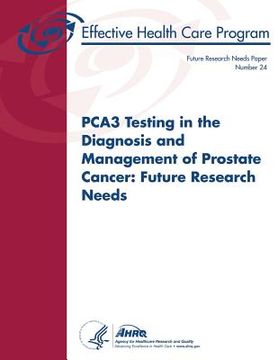PCA3 Testing in the Diagnosis and Management of Prostate Cancer: Future Research Needs: Future Research Needs Paper Number 24
Synopsis "PCA3 Testing in the Diagnosis and Management of Prostate Cancer: Future Research Needs: Future Research Needs Paper Number 24"
Cancer of the prostate is the second most common cancer and the second leading cause of cancer deaths in men in the U.S. Most patients have indolent tumors and may live for years with no or minimal effects, ultimately dying of other causes. Some patients have aggressive tumors that spread beyond the prostate, resulting in significant morbidity and death. The rationale for prostate cancer screening using serum total prostate-specific antigen (tPSA) levels was that early detection of prostate tumors would lead to timely intervention and reduced prevalence of disease. Screening programs have generated considerable controversy, with concerns expressed that they lead to overdiagnosis and overtreatment of prostate cancer and associated harms. In April 2012, a draft CER, PCA3 Testing for the Diagnosis and Management of Prostate Cancer, was completed. The review had two aims. The first was to evaluate the comparative effectiveness of replacing or supplementing existing testing approaches for decisionmaking on when to biopsy (KQ1) or rebiopsy (KQ2) men at risk for prostate cancer. KQs 1 and 2 were as follows. KQ1: In patients with elevated tPSA and/or an abnormal digital rectal examination (DRE) who are candidates for initial prostate biopsy, what is the comparative effectiveness of PCA3 testing as a replacement for, or supplement to, standard tests, including diagnostic accuracy (clinical validity) for prostate cancer, intermediate outcomes, and long-term health outcomes (clinical utility), including mortality/morbidity, quality of life, and potential harms? KQ2: In patients with elevated PSA and/or an abnormal DRE who are candidates for repeat prostate biopsy (when all previous biopsies were negative), what is the comparative effectiveness of PCA3 testing as a replacement for, or supplement to, standard tests, including diagnostic accuracy (clinical validity) for prostate cancer, intermediate outcomes, and long-term health outcomes (clinical utility), including mortality/morbidity, quality of life, and potential harms? The second aim (KQ3) was to evaluate the comparative effectiveness of replacing or supplementing existing approaches for categorizing men with a positive prostate cancer biopsy as having high- or low-risk cancer and making decisions about treatment. KQ3 was as follows. KQ3: In patients with a positive biopsy for prostate cancer who are being evaluated to distinguish between indolent and aggressive disease, what is the effectiveness of using PCA3 testing alone, or in combination with the standard prognostic workup or monitoring tests, with regard to diagnostic accuracy (clinical validity) for aggressive (high-risk) prostate cancer, intermediate outcomes, and long-term health outcomes (clinical utility), including mortality/morbidity, quality of life, and potential harms? Several important evidence gaps were identified in the draft PCA3 CER: Lack of information on how much improvement in diagnostic accuracy is needed for any new test to impact biopsy decisionmaking; Lack of information on the potential of adding PCA3 alone or with other biomarkers to change decisionmaking in practice; Lack of information on how PCA3 compares in terms of diagnostic accuracy and clinical utility with the two more frequently used add-on tests (free PSA, PSA velocity) that have appeared in guidance documents; Need for matched studies not derived from "convenience" populations and more data on how key demographic factors (family history, race) impact the performance of PCA3 and comparators; Need for outcome studies to determine how well PCA3 and other comparators used to categorize risk as insignificant/indolent or aggressive predict the behavior of tumors over time; Lack of information on a range of methodological and statistical questions related to modeling, assessing the impact of verification bias, identifying most effective cutoffs for tests based on Reviewer Operating Characteristic analysis, and designs for future studies.

